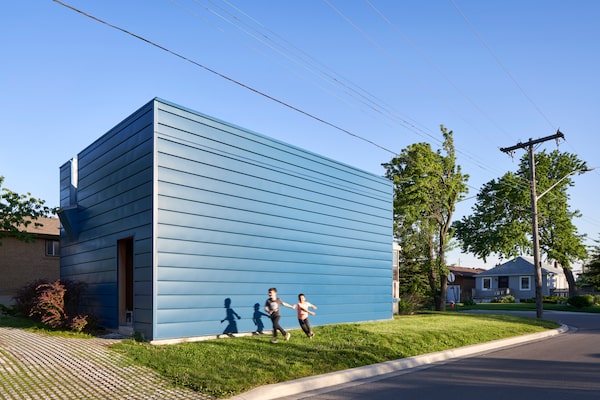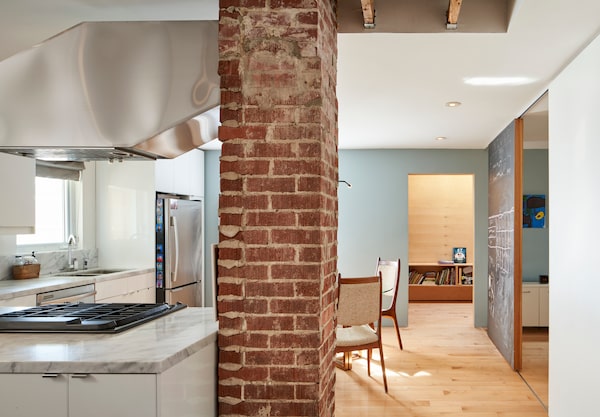
Joey Giaimo’s family home does not seem to blend in the old Mississauga neighbourhood.doublespace photography/Courtesy of Joey Giaimo
One thing you can say about Joey Giaimo’s family home in old Mississauga: It does not blend in. Out front it remains a homely 1920s bungalow; on the side and the back, it morphs into a rectangular block wrapped in blue steel.
This piecemeal nature speaks to the evolution of the area, which was built in bits and pieces through the 20th century. It also reveals the sensibility of Mr. Giaimo, an architect who specializes in working with existing buildings.
“At our firm, we base our work on research, looking into the architectural lineage of a place,” he tells me over coffee at his kitchen table. An exposed wire-brick chimney pokes through the floor nearby, brushing up against a new marble counter. “The old and the new need to sing together.”
Mr. Giaimo has a very interesting concept of what that music should sound like. With the architecture of this house – where he lives with Joanne Casiero, his wife and business partner, and their two sons – Mr. Giaimo shows how older buildings can form part of an ongoing conversation.

The kitchen has an exposed wire-brick chimney, brushing up against a new marble counter.Courtesy of Joey Giaimo/Courtesy of Joey Giaimo
Mr. Giaimo and Ms. Casiero bought the house about a decade ago. In some ways their story is typical: They found an inexpensive bungalow in a convenient spot and have added on to the house as their family grows.
But the method of that expansion is novel. Mr. Giaimo designed the addition to fit around the side and back (the north and east) sides of the house; if you draw a diagram, the original footprint and the new one are overlapping rectangles.
You enter from the back, through a cedar front door set into the blue steel of the new volume. From there, visitors move along a rising corridor between the new maple-wrapped outer wall and one outer wall of the original bungalow – hanging in place, like an archaeological exhibit, but with its cladding stripped off to reveal the pine lumber that lay underneath.

Mr. Giaimo shows how older buildings can form part of an ongoing conversation.Courtesy of Joey Giaimo/Courtesy of Joey Giaimo
This corridor is indoors and yet outside the original house; it is a space in between. Up above, a row of L-shaped wooden brackets support an irregular roof that dips down toward the middle, then back up; Mr. Giaimo and his colleagues designed this complex geometry using digital design tools. And as Mr. Giaimo points out, there are at least four different species of wood in this area alone. There’s a lot going on.
“Part of the idea of this house,” Mr. Giaimo admits, “is to explore some ideas that we’re working on in the practice.” This is a familiar purpose for an architect’s house, and Mr. Giaimo’s evokes a very good one in particular: Frank Gehry’s. In the 1970s, Mr. Gehry took an ordinary Dutch Colonial house in a Southern California neighbourhood and blew it up, adding jagged appendages of glass, metal, plywood and chain-link. If the original architecture was about convention and domesticity, Mr. Gehry’s renovation was about the opposite; he was colouring outside the lines.
Mr. Giaimo, in his more quiet manner, has done the same thing. The corridor’s mix of woods directly evokes Mr. Gehry’s plywood fantasias. So does the house’s spatial complexity. The bungalow steps down half a level into the addition, to the couple’s master bedroom, and then down another half-level to the basement, which looks out on a sunken courtyard.

The corridor’s mix of woods directly evokes Frank Gehry's plywood fantasias.Courtesy of Joey Giaimo/Courtesy of Joey Giaimo
Here, the floor is made of marble slabs, removed from the facade of the First Canadian Place skyscraper in downtown Toronto. “They aren’t pristine,” Mr. Giaimo says. “They’re a bit weathered; they show the history. We like them that way.”
Reusing bits of another building is not what typically passes for heritage architecture. The orthodox version of that work involves studying an existing building and figuring out how to restore or preserve one particular piece while the site is redeveloped.
Mr. Giaimo can do that, too; he worked for years with the heritage specialists ERA, which consult on major developments in Toronto and the region. Today, his own firm is working on the restoration of the Oculus, a 1959 pavilion in Toronto’s South Humber Park.
But with his house, he’s proposing a different understanding entirely: seeing buildings, past and present, as products of their time that can evolve. “With this house, every piece is critical to the design,” he said. “You look at the original architecture and feed off it to build a new intervention.”
That’s not how most of us think about old houses, or about the history of our cities, but it ought to be.
Your house is your most valuable asset. We have a weekly Real Estate newsletter to help you stay on top of news on the housing market, mortgages, the latest closings and more. Sign up today.
 Alex Bozikovic
Alex Bozikovic